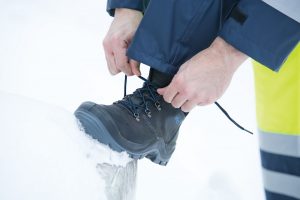Safety and occupational (work) footwear in the light of applicable law
 In accordance with the Labour Code Act of 26 June 1974 (the Journal of Laws of 1974, No. 24, item 141), the employer is obliged to provide an employee with personal protective equipment to protect them against dangerous factors and factors harmful to health. It includes both work clothing and footwear that meet the requirements set out in Polish Standards. It is worth noting that according to the current regulations shoes which do not have protective features and are designed only for use in the workplace for reasons related to technological, sanitary or hygienic requirements or in order to protect the employees’ own shoes, are called occupational footwear. Such footwear is also often referred to as work footwear.
In accordance with the Labour Code Act of 26 June 1974 (the Journal of Laws of 1974, No. 24, item 141), the employer is obliged to provide an employee with personal protective equipment to protect them against dangerous factors and factors harmful to health. It includes both work clothing and footwear that meet the requirements set out in Polish Standards. It is worth noting that according to the current regulations shoes which do not have protective features and are designed only for use in the workplace for reasons related to technological, sanitary or hygienic requirements or in order to protect the employees’ own shoes, are called occupational footwear. Such footwear is also often referred to as work footwear.
Types and classification of safety footwear according to EN ISO 20345:
There are many criteria for dividing footwear designed for work. It can be broken down by model, use or hazard level.
Taking into account the level of hazards which footwear should protect from we distinguish:
- safety footwear (S) – EN ISO 20345 – the toe cap of the shoe withstands impact with energy of 200 J and crushing to 15 kN.
- occupational footwear (O) – EN ISO 20347 – designed for everyday use where it is not necessary to protect toes with toe caps. Such footwear is often referred to as work footwear.
In accordance with the above standards, both safety and occupational footwear should be classified as follows:
- Category I – Footwear made of leather or other materials, excluding all rubber and all plastic footwear
- Category II – All rubber (i.e. completely vulcanised) or all plastic (i.e. completely moulded) footwear.
Category I:
- SB – Energy absorption by a metal toe cap which withstands impact with energy of 200 J and crushing up to 15 kN; resistance to oils, petrol and other organic solvents.
- S1 – Energy absorption by a metal toe cap which withstands impact with energy of 200 J and crushing up to 15 kN; resistance to oils, petrol and other organic solvents; slip resistance, closed heel area, energy absorption in the heel, antistatic properties.
- S2 – Energy absorption by a metal toe cap which withstands impact with energy of 200 J and crushing up to 15 kN; resistance to oils, petrol and other organic solvents; slip resistance, closed heel area, energy absorption in the heel, antistatic properties, resistance to moisture absorption and water penetration.
- S3 – Energy absorption by a metal toe cap which withstands impact with energy of 200 J and crushing up to 15 kN; resistance to oils, petrol and other organic solvents; slip resistance, closed heel area, energy absorption in the heel, antistatic properties, resistance to moisture absorption and water penetration, cleated outsole, penetration resistance.
Category II:
- S4 – Metal toe cap (toe protection) which withstands impact with energy of 200 J and crushing up to 15 kN; resistance to oils, petrol and other organic solvents; slip resistance, encased heel, energy absorption in the heel, antistatic properties.
- S4 – Metal toe cap (toe protection) which withstands impact with energy of 200 J and crushing up to 15 kN; resistance to oils, petrol and other organic solvents; closed heel, energy absorption in the heel, antistatic properties, penetration resistance, cleated outsole.
Symbols used to indicate the individual characteristics of footwear:
P – penetration resistance
A – antistatic footwear
C – electro-conductive footwear
I – electrically insulating footwear
HI – bottom heat insulation
CI – bottom cold insulation
E – energy absorption around heel
WR – water resistance
M – metatarsal protection
AN – ankle protection
WRU – water penetration and water absorption upper
CR – resistance to cutting of the upper layer
HRO – heat resistance of outsole (300°C/min)
FO – resistance of the outsole to contact with oil fuels
SRA – slip resistance of the bottom on a ceramic tile substrate covered with sodium lauryl sulfate solution
SRB – slip resistance of the outstole on steel floors with glycerol
SRC – slip resistance of the outsole on ceramic tile floors with sodium lauryl sulfate solution and on steel floors with glycerol
 The employer may specify, by means of an internal act (e.g. rules and regulations), the workstations at which the use of shoes with appropriate parameters is required. In addition, the employer can indicate workstations at which, with the employee’s consent, the use of the employee’s own shoes as occupational footwear is permitted, provided that these shoes meet occupational health and safety requirements. If an employee works in their own shoes, the company is obliged to pay the employee compensation for damaged property, usually in the form of money. It is forbidden to use one’s own shoes when directly operating machines and other technical equipment and in places that cause intensive soiling or contamination of footwear with chemicals, radioactive substances or biological material.
The employer may specify, by means of an internal act (e.g. rules and regulations), the workstations at which the use of shoes with appropriate parameters is required. In addition, the employer can indicate workstations at which, with the employee’s consent, the use of the employee’s own shoes as occupational footwear is permitted, provided that these shoes meet occupational health and safety requirements. If an employee works in their own shoes, the company is obliged to pay the employee compensation for damaged property, usually in the form of money. It is forbidden to use one’s own shoes when directly operating machines and other technical equipment and in places that cause intensive soiling or contamination of footwear with chemicals, radioactive substances or biological material.
Under applicable law, occupational footwear must be supplied to the employee free of charge, and the usage period of the shoes must be determined in consultation with the employer. Remember that footwear remains the property of the employer, who is obliged to ensure proper maintenance and decontamination, and if possible washing of the footwear. Alternatively, the user of the shoes may do so, but the employer is obliged to pay a cash equivalent equal to the costs incurred by the employee.
The supply of occupational workwear or the use of one’s own shoes as occupational footwear, in turn, imposes an obligation on the employee to use them. The employer has the full right, and in fact a duty, to prevent a person who does not have adequate personal protective equipment from entering the workplace.



 polski
polski  Deutsch
Deutsch  English
English 
